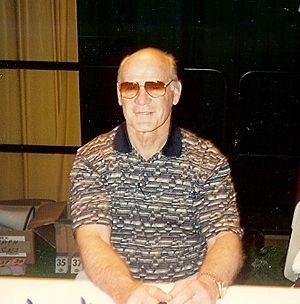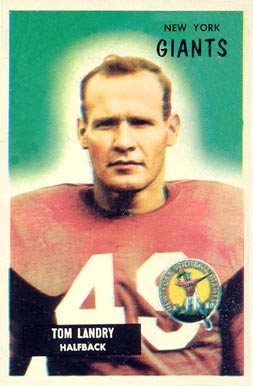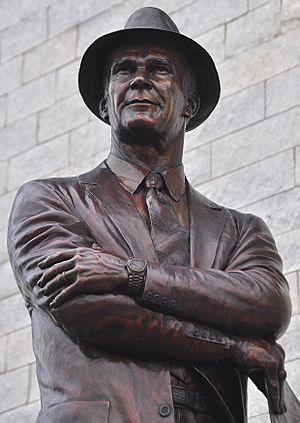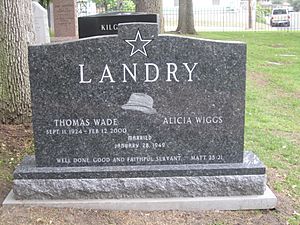Tom Landry facts for kids

Landry in January 1997
|
|||||||||
| No. 49 | |||||||||
|---|---|---|---|---|---|---|---|---|---|
| Position: | Back, Punter | ||||||||
| Personal information | |||||||||
| Born: | September 11, 1924 Mission, Texas, U.S. |
||||||||
| Died: | February 12, 2000 (aged 75) Dallas, Texas, U.S. |
||||||||
| Career information | |||||||||
| High school: | Mission (TX) | ||||||||
| College: | Texas | ||||||||
| NFL Draft: | 1947 / Round: 20 / Pick: 184 | ||||||||
| Career history | |||||||||
| As player: | |||||||||
|
|||||||||
| As coach: | |||||||||
|
|||||||||
| Career highlights and awards | |||||||||
|
|||||||||
| Career NFL statistics | |||||||||
|
|||||||||
| Head coaching record | |||||||||
| Regular season: | 250–162–6 (.605) | ||||||||
| Postseason: | 20–16 (.556) | ||||||||
| Career: | 270–178–6 (.601) | ||||||||
| Military career | |||||||||
| Allegiance | |||||||||
| Service/ |
|||||||||
| Years of service | 1942–1945 | ||||||||
| Rank | |||||||||
| Unit | Eighth Air Force 493d Bombardment Group 860th Bombardment Squadron |
||||||||
| Battles/wars | World War II Air War Over Europe |
||||||||
| Coaching stats at PFR | |||||||||
|
Pro Football Hall of Fame
|
|||||||||
Thomas Wade Landry (born September 11, 1924 – died February 12, 2000) was a famous American football player and coach. Many people think he was one of the best coaches ever. He was the very first head coach for the Dallas Cowboys in the National Football League (NFL), coaching them for 29 years!
Tom Landry invented new ways to play, like the popular "4–3 defense" and the "flex defense." These helped his team, the "Doomsday Defense" Cowboys, become super strong. He coached the same team for 29 years in a row (from 1960 to 1988), which is an NFL record. He also had 20 winning seasons in a row, which is amazing!
From 1966 to 1985, Tom Landry's teams had 20 winning seasons in a row. He led the Cowboys to win two Super Bowl titles (Super Bowl VI and Super Bowl XII). They also won five NFC titles and 13 division titles. His overall coaching record was 270 wins, 178 losses, and 6 ties. This makes him the fourth-winningest coach in NFL history. He also won 20 playoff games, which is the second most for any NFL coach. Landry was named NFL Coach of the Year in 1966 and NFC Coach of the Year in 1975.
Between 1970 and 1978, the Cowboys played in five Super Bowls. They were on TV more than any other NFL team, which led to them being called "America's Team." However, Landry didn't like this name because he thought it would make other teams want to beat them even more. Tom Landry was added to the Pro Football Hall of Fame in 1990.
Contents
Early Life and Military Service
Tom Landry was born in Mission, Texas. His father, Ray, was an auto mechanic and volunteer firefighter. His mother was Ruth Coffman. Tom was the second of four children. His father moved to Texas from Illinois because the warmer weather helped with his rheumatism. Ray Landry was also a good athlete, known for playing baseball and football.
Tom played quarterback and punter for Mission High School. In his senior year, he led his team to a perfect 12–0 record. The football stadium at Mission High School is now named Tom Landry Stadium to honor him.
College Years and World War II
Landry went to the University of Texas at Austin to study industrial engineering. He thought about going to Mississippi State University, but he wanted to stay close to his family and friends in Texas. He knew it would be too far for his parents to watch him play college football there.
After one semester, he paused his studies to join the United States Army Air Corps during World War II. He was inspired by his older brother, Robert, who had joined after the attack on Pearl Harbor. Sadly, Robert's plane went down over the North Atlantic near Iceland, and he was declared dead.
Tom Landry started his training at Sheppard Field in Texas. At 19, he trained as a copilot for a B-17 bomber in Iowa. In 1944, he went to England and joined the Eighth Air Force. He became a Second Lieutenant and a B-17 bomber copilot. From November 1944 to April 1945, he flew 30 combat missions. He even survived a crash landing in Belgium when his bomber ran out of fuel.
After the war, he returned to the University of Texas in 1946. He played fullback and defensive back for the Texas Longhorns. They won bowl games in 1948 and 1949. He earned his bachelor's degree in 1949. In 1952, he also earned a master's degree in industrial engineering from the University of Houston.
Playing Career Highlights
Tom Landry was picked by the New York Yankees in the 1948 AAFC Draft. He played one season in the All-America Football Conference (AAFC). In 1950, he moved to the New York Giants in the NFL.
The Giants had also picked Landry in the 1947 NFL Draft. When the AAFC league closed down after the 1949 season, the Giants officially added him to their team.
While playing for the Giants, Landry got his first taste of coaching. His head coach, Steve Owen, asked Landry to explain a new defense to his teammates. Landry did, and this was his first coaching experience. In 1954, he was chosen as an All-Pro player, meaning he was one of the best in the league.
He played until the 1955 season. For his last two years (1954-1955), he was a player and an assistant coach under the new head coach, Jim Lee Howell. Landry finished his playing career with 32 interceptions in just 80 games. He also recovered 10 fumbles.
Career Statistics as a Player
| Led the NFL | |
| Led the AAFC |
- Special teams
| Year | Team | G | Punting | Kick returns | Punt returns | ||||||||||
|---|---|---|---|---|---|---|---|---|---|---|---|---|---|---|---|
| Punts | Yards | Avg | Long | Block | KR | Yards | Avg | TD | PR | Yards | Avg | TD | |||
| 1949 | NY Yankees | 12 | 51 | 2,249 | 44.1 | – | 2 | 2 | 39 | 19.5 | 0 | 3 | 52 | 17.3 | 0 |
| 1950 | NY Giants | 10 | 58 | 2,136 | 36.8 | 61 | 1 | – | – | – | – | – | – | – | – |
| 1951 | NY Giants | 12 | 15 | 638 | 42.5 | 59 | 0 | 1 | 0 | 0.0 | 0 | 1 | 0 | 0.0 | 0 |
| 1952 | NY Giants | 12 | 82 | 3,363 | 41.0 | 61 | 1 | 1 | 20 | 20.0 | 0 | 10 | 88 | 8.8 | 0 |
| 1953 | NY Giants | 12 | 44 | 1,772 | 40.3 | 60 | 0 | 2 | 38 | 19.0 | 0 | 1 | 5 | 5.0 | 0 |
| 1954 | NY Giants | 12 | 64 | 2,720 | 42.5 | 61 | 0 | – | – | – | – | – | – | – | – |
| 1955 | NY Giants | 12 | 75 | 3,022 | 40.3 | 69 | 1 | – | – | – | – | – | – | – | – |
| Career (1949–1955) | 82 | 389 | 15,900 | 40.9 | 69 | 5 | 6 | 97 | 16.2 | 0 | 15 | 145 | 9.7 | 0 | |
| AAFC stats (1949) | 12 | 51 | 2,249 | 44.1 | – | 2 | 2 | 39 | 19.5 | 0 | 3 | 52 | 17.3 | 0 | |
| NFL stats (1950–55) | 70 | 338 | 13,651 | 40.4 | 69 | 3 | 4 | 58 | 14.5 | 0 | 12 | 93 | 7.8 | 0 | |
Coaching the Dallas Cowboys
In 1954, Landry became the defensive coordinator for the New York Giants. He worked alongside Vince Lombardi, who was the offensive coordinator. Landry built one of the best defenses in the league from 1956 to 1959. Their coaching helped the Giants reach the NFL championship game three times in four years. They won in 1956 but lost in 1958 and 1959.
In 1960, Tom Landry became the very first head coach of the Dallas Cowboys. He held this job for 29 seasons, until 1988. The Cowboys had a tough start, winning only one game in their first season. They had five or fewer wins in their next four seasons.
Despite the early struggles, the team owner, Clint Murchison Jr., gave Landry a 10-year contract extension in 1964. This was a smart move! Landry's hard work paid off. In 1965, the Cowboys improved to a 7–7 record. In 1966, they surprised everyone by winning 10 games and reaching the NFL Championship game. They lost to Lombardi's Green Bay Packers, but this was just the beginning of their success.
Landry's Coaching Innovations
Tom Landry created the famous "4–3 defense" when he was the Giants' defensive coordinator. It's called "4–3" because it uses four linemen and three linebackers. The big new idea was the "middle linebacker," a player who stood back a bit from the line. The Giants' middle linebacker was the legendary Sam Huff.
When Landry came to Dallas, he made the 4–3 defense even better. He wanted to stop Lombardi's "run to daylight" offense, where running backs would look for any open space. Landry's answer was the "Flex Defense." This defense made sure defenders covered specific areas of the field. When he first used it in 1964, fans were confused because the Cowboys' defense didn't always rush the ball. But soon, they saw that ball carriers often ran right into one of Landry's defenders. The Flex Defense worked so well that Landry had to create a new offense to score against it!
Landry also looked for talent in unusual places. For example, he recruited soccer players from Latin America, like Efren Herrera and Rafael Septién, to be kickers for the Cowboys. He also looked at track and field athletes for fast players. Bob Hayes, once known as the fastest man in the world, became a wide receiver for the Cowboys under Landry.
Many coaches who worked for Landry later became head coaches themselves. In 1986, five NFL head coaches had been Landry's assistants: Mike Ditka, Dan Reeves, John Mackovic, Gene Stallings, and Raymond Berry.
Super Bowl Appearances
Tom Landry's Cowboys are famous for their two Super Bowl games against Chuck Noll and the Pittsburgh Steelers. But Landry also led Dallas to three other Super Bowls. They were very close to reaching a second Super Bowl, losing by just one play in the 1967 NFL Championship game. Landry's record in Super Bowls was 2 wins and 3 losses. He won both Super Bowls played in New Orleans and lost all three played in Miami.
Landry coached the Cowboys to their first Super Bowl win in 1972. They beat the Miami Dolphins 24–3, holding the Dolphins to only a field goal. This win came a year after the Cowboys lost to the Baltimore Colts in Super Bowl V.
The Cowboys lost their first Super Bowl battle with the Steelers in a game that many remember as a classic. The rematch was just as exciting. The Cowboys were close to tying the Steelers early in the third quarter, but a missed catch changed things. Pittsburgh then scored twice and won the game. Before that rematch, Cowboys linebacker Thomas "Hollywood" Henderson made a famous comment about the Steelers' quarterback, Terry Bradshaw. Landry later said he didn't like that comment because he felt Bradshaw didn't need extra motivation for such a big game.
Dismissal and Lasting Legacy
In the 1980s, the Cowboys won two division championships and made the playoffs five times. They reached the NFC Championship Game three years in a row (1980–1982) but couldn't make it to the Super Bowl. The last of those games was in 1982, when they lost to the Washington Redskins. After that, Landry never reached the NFC Championship game again or won another playoff game.
In 1984, a businessman named Bum Bright bought the team. As the Cowboys had worse seasons (from 10 wins in 1985 to 3 wins in 1988), Bright became unhappy. Landry's coaching strategies during these years led to some public criticism.
Landry had signed a three-year contract in 1987. However, Bright eventually sold the team to Jerry Jones. One day after Jones bought the team, he fired Landry. Jones hired Jimmy Johnson, who had been his college teammate. The general manager, Tex Schramm, who had worked with Landry for 29 years, was very sad at the press conference. He was also forced out of his job soon after. When Landry met with his players to say goodbye, he cried, and the players gave him a standing ovation.
Many people were upset about how Landry was fired. Fans and the media felt it was disrespectful to a coach who had built the Cowboys into champions. Jerry Jones has since said he regrets how Landry's firing was handled. Even today, some fans are still upset with Jones over it.
By 1993, things between Jones and Landry had gotten better. Landry was added to the Dallas Cowboys Ring of Honor at Texas Stadium.
Landry's last job in football was as a "limited partner" for the San Antonio Riders in the World League in 1992.
Head Coaching Record
| Team | Year | Regular season | Postseason | |||||||
|---|---|---|---|---|---|---|---|---|---|---|
| Won | Lost | Ties | Win % | Finish | Won | Lost | Win % | Result | ||
| DAL | 1960 | 0 | 11 | 1 | .042 | 7th in NFL West | — | — | — | — |
| DAL | 1961 | 4 | 9 | 1 | .321 | 6th in NFL East | — | — | — | — |
| DAL | 1962 | 5 | 8 | 1 | .393 | 5th in NFL East | — | — | — | — |
| DAL | 1963 | 4 | 10 | 0 | .286 | 5th in NFL East | — | — | — | — |
| DAL | 1964 | 5 | 8 | 1 | .393 | 5th in NFL East | — | — | — | — |
| DAL | 1965 | 7 | 7 | 0 | .500 | 2nd in NFL East | — | — | — | — |
| DAL | 1966 | 10 | 3 | 1 | .750 | 1st in NFL East | 0 | 1 | .000 | Lost to Green Bay Packers in NFL Championship Game |
| DAL | 1967 | 9 | 5 | 0 | .643 | 1st in NFL Capitol | 1 | 1 | .500 | Lost to Green Bay Packers in NFL Championship Game |
| DAL | 1968 | 12 | 2 | 0 | .857 | 1st in NFL Capitol | 0 | 1 | .000 | Lost to Cleveland Browns in Eastern Conference Championship Game |
| DAL | 1969 | 11 | 2 | 1 | .821 | 1st in NFL Capitol | 0 | 1 | .000 | Lost to Cleveland Browns in Eastern Conference Championship Game |
| DAL | 1970 | 10 | 4 | 0 | .714 | 1st in NFC East | 2 | 1 | .667 | Lost to Baltimore Colts in Super Bowl V |
| DAL | 1971 | 11 | 3 | 0 | .786 | 1st in NFC East | 3 | 0 | 1.000 | Super Bowl VI champions |
| DAL | 1972 | 10 | 4 | 0 | .714 | 2nd in NFC East | 1 | 1 | .500 | Lost to Washington Redskins in NFC Championship Game |
| DAL | 1973 | 10 | 4 | 0 | .714 | 1st in NFC East | 1 | 1 | .500 | Lost to Minnesota Vikings in NFC Championship Game |
| DAL | 1974 | 8 | 6 | 0 | .571 | 3rd in NFC East | — | — | — | — |
| DAL | 1975 | 10 | 4 | 0 | .714 | 2nd in NFC East | 2 | 1 | .667 | Lost to Pittsburgh Steelers in Super Bowl X |
| DAL | 1976 | 11 | 3 | 0 | .786 | 1st in NFC East | 0 | 1 | .000 | Lost to Los Angeles Rams in NFC Divisional Game |
| DAL | 1977 | 12 | 2 | 0 | .857 | 1st in NFC East | 3 | 0 | 1.000 | Super Bowl XII champions |
| DAL | 1978 | 12 | 4 | 0 | .750 | 1st in NFC East | 2 | 1 | .667 | Lost to Pittsburgh Steelers in Super Bowl XIII |
| DAL | 1979 | 11 | 5 | 0 | .688 | 1st in NFC East | 0 | 1 | .000 | Lost to Los Angeles Rams in NFC Divisional Game |
| DAL | 1980 | 12 | 4 | 0 | .750 | 2nd in NFC East | 2 | 1 | .667 | Lost to Philadelphia Eagles in NFC Championship Game |
| DAL | 1981 | 12 | 4 | 0 | .750 | 1st in NFC East | 1 | 1 | .500 | Lost to San Francisco 49ers in NFC Championship Game |
| DAL | 1982 | 6 | 3 | 0 | .667 | 2nd in NFC | 2 | 1 | .667 | Lost to Washington Redskins in NFC Championship Game |
| DAL | 1983 | 12 | 4 | 0 | .750 | 2nd in NFC East | 0 | 1 | .000 | Lost to Los Angeles Rams in NFC Wild Card Game |
| DAL | 1984 | 9 | 7 | 0 | .563 | 4th in NFC East | — | — | — | — |
| DAL | 1985 | 10 | 6 | 0 | .667 | 1st in NFC East | 0 | 1 | .000 | Lost to Los Angeles Rams in NFC Divisional Game |
| DAL | 1986 | 7 | 9 | 0 | .438 | 3rd in NFC East | — | — | — | — |
| DAL | 1987 | 7 | 8 | 0 | .467 | 2nd in NFC East | — | — | — | — |
| DAL | 1988 | 3 | 13 | 0 | .188 | 5th in NFC East | — | — | — | — |
| Total | 250 | 162 | 6 | .605 | 20 | 16 | .556 | |||
Coaching Tree
Many coaches who worked for Tom Landry later became head coaches themselves. This is often called a "coaching tree." Here are some of the coaches who came from Landry's tree:
- Dick Nolan, who coached the San Francisco 49ers and New Orleans Saints.
- Dan Reeves, who coached the Denver Broncos, New York Giants, and Atlanta Falcons.
- Mike Ditka, who coached the Chicago Bears and New Orleans Saints.
- Raymond Berry, who coached the New England Patriots.
- John Mackovic, who coached the Kansas City Chiefs and several college teams.
- Ron Meyer, who coached college teams and NFL teams like the New England Patriots and Indianapolis Colts.
- Gene Stallings, who coached the St. Louis/Phoenix Cardinals and the University of Alabama.
Later Life and Legacy
Tom Landry passed away on February 12, 2000, after fighting leukemia. His funeral was held at Highland Park United Methodist Church in Dallas, where he had been a dedicated member for 43 years. He was buried in the Sparkman-Hillcrest Memorial Park Cemetery in Dallas. A special memorial, called a cenotaph, was placed in the official Texas State Cemetery in Austin. It even has a picture of his famous fedora hat.
The Cowboys wore a patch on their uniforms during the 2000 season that showed Landry's trademark fedora. A bronze statue of Landry used to stand outside Texas Stadium. Now, it stands in front of AT&T Stadium, where the Cowboys play today.
In 2001, the section of Interstate 30 between Dallas and Fort Worth was named the Tom Landry Highway. The football stadium in Landry's hometown of Mission, Texas, is also named Tom Landry Stadium. Another stadium at Trinity Christian Academy in Addison, Texas, is named after him because of his support for the school. An elementary school in the Carrollton-Farmers Branch school district is also named in his honor. The Tom Landry Welcome Center at Dallas Baptist University, where he often spoke, was dedicated to him in 2002.
In 2013, a new book about Landry was published, called The Last Cowboy.
Awards and Honors
- 1966: Won the National Football League Coach of the Year Award
- 1978: Received the Golden Plate Award from the American Academy of Achievement
- 1989: Honored by the city of Dallas
- 1990: Inducted into the Pro Football Hall of Fame
- 1993: Inducted into the Dallas Cowboys' "Ring of Honor"
Personal Life
Tom Landry married Alicia Wiggs on January 28, 1949. They had a son and two daughters. He was a Christian. Alicia Landry passed away on January 21, 2021, at the age of 91.
When coaching on the sidelines, Tom Landry always wore a suit and tie with his famous fedora hat.
See also
 In Spanish: Tom Landry para niños
In Spanish: Tom Landry para niños
- List of National Football League head coaches with 50 wins
- List of professional gridiron football coaches with 200 wins




